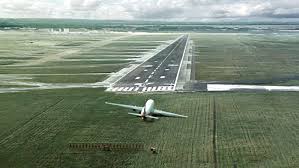SIZING OF AIRCRAFT ACCORDING TO TAKEOFF DISTANCE REQUIREMENT
The take off ground run (STOG) of an aircraft is proportional to takeoff wing loading (W/S)TO, or take off power loading (W/P)TO . and maximum take off lift CLmax .
i.e, STO a ( (W/S)TO* (W/P)TO ) / (sCLmax) = TOP ——-(1)
this equals to TOP (take off parameter ) and its dimension is newton2/ m2hp .
As we know that the coefficient of lift at take off is typically 1.21 times maximum lift coefficient.
So we can write it as a CTO = CLmaxTO / 1.21
Below Fig relates STOG to the take off parameter . for a range of aircraft of single and twin engine (source by aircraft flight dynamics and automotive flight control , Roskam.).
This graph suggest following relationship
STOG = 4.9 TOP +0.009TOP2 ———————(2)
And , fig Below implies that ,
STO = 1.66 STOG ————(3)
NOW from above two equation we get,
STO = 8.134 TOP + 0.0149 TOP2 ———–(4)
THIS EQUATION are generated on the basis of data from FAR 23 aircraft.
For the calculation for jet aircraft we might replace (W/P) TO (W/T).
Here is one example so that the above concept will clear to everyone.
For a given aircraft (take propeller driven) it is specified that STOG LESS THAN 1000m and STO IS LESS THAN 1500m at an altitude of 5000 ft in standard atmosphere.
Equation (3) stipulates that ,
STO < 1660m
This clearly violate the second requirement. So for both takeoff requirement to be met it is necessary that ,
1500 = 8.134TOP + 0.0149 TOP2
FROM this we get TOP = 145.6
Since s = 0.8616 at 5000 ft , now put this values in eq—-(1) it translate into ( (W/S)TO* (W/P)TO ) / (CLmax) < 145.6 *0.8616
Now by putting the values of (CLmax) and (W/P)TO we get approximate value of (W/S)TO







